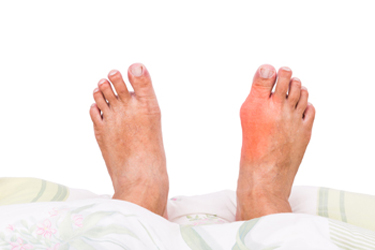 The medical term referred to as gout will typically affect the big toe and surrounding areas. Typical symptoms may generally include severe pain and discomfort in the area of the big toe, heat that may radiate from the foot, in addition to swelling and redness. It occurs as a result of elevated uric acid levels in the blood, which causes crystals to form in the joints. There may be several reasons for this to happen, including diabetes, high blood pressure, or congestive heart failure. Additionally, eating foods that have elevated fructose levels may lead to the onset of gout, in addition to drinking excess alcohol, or eating red meat or seafood. Successful prevention and treatment of gout may begin with eating healthy foods and implementing a gentle exercise program. If obesity exists, it may be helpful to lose excess weight which may aid in protecting the joints. If you are having gout attacks, it is advised to speak to a podiatrist who can properly treat this condition.
The medical term referred to as gout will typically affect the big toe and surrounding areas. Typical symptoms may generally include severe pain and discomfort in the area of the big toe, heat that may radiate from the foot, in addition to swelling and redness. It occurs as a result of elevated uric acid levels in the blood, which causes crystals to form in the joints. There may be several reasons for this to happen, including diabetes, high blood pressure, or congestive heart failure. Additionally, eating foods that have elevated fructose levels may lead to the onset of gout, in addition to drinking excess alcohol, or eating red meat or seafood. Successful prevention and treatment of gout may begin with eating healthy foods and implementing a gentle exercise program. If obesity exists, it may be helpful to lose excess weight which may aid in protecting the joints. If you are having gout attacks, it is advised to speak to a podiatrist who can properly treat this condition.
Gout is a foot condition that requires certain treatment and care. If you are seeking treatment, contact Brent Harwood, DPM from Southeast Podiatry. Our doctor will treat your foot care needs.
What Is Gout?
Gout is a type of arthritis caused by a buildup of uric acid in the bloodstream. It often develops in the foot, especially the big toe area, although it can manifest in other parts of the body as well. Gout can make walking and standing very painful and is especially common in diabetics and the obese.
People typically get gout because of a poor diet. Genetic predisposition is also a factor. The children of parents who have had gout frequently have a chance of developing it themselves.
Gout can easily be identified by redness and inflammation of the big toe and the surrounding areas of the foot. Other symptoms include extreme fatigue, joint pain, and running high fevers. Sometimes corticosteroid drugs can be prescribed to treat gout, but the best way to combat this disease is to get more exercise and eat a better diet.
If you have any questions please feel free to contact one of our offices located in Fairhope, Brewton, and Atmore, AL . We offer the newest diagnostic and treatment technologies for all your foot care needs.
Read more about Everything You Need to Know About Gout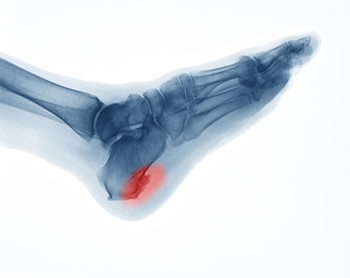 There are many conditions that can cause discomfort in the heel, but one of the most common is heel spurs. A small calcium deposit forms and can eventually extend from your heel bone to your arch. Symptoms associated with heel spurs are pain, inflammation, and swelling at the front of your heel. The heel might also feel warm, and over time, a small protrusion could be visible. Some heel spurs can go unnoticed and only become apparent on an X-ray. Heel spurs develop over time, so they will not suddenly appear. Distinguishing heel spurs from other conditions that cause heel pain can be hard to do on your own, so if you are experiencing heel pain then it is suggested that you speak with a podiatrist who can properly diagnosis you.
There are many conditions that can cause discomfort in the heel, but one of the most common is heel spurs. A small calcium deposit forms and can eventually extend from your heel bone to your arch. Symptoms associated with heel spurs are pain, inflammation, and swelling at the front of your heel. The heel might also feel warm, and over time, a small protrusion could be visible. Some heel spurs can go unnoticed and only become apparent on an X-ray. Heel spurs develop over time, so they will not suddenly appear. Distinguishing heel spurs from other conditions that cause heel pain can be hard to do on your own, so if you are experiencing heel pain then it is suggested that you speak with a podiatrist who can properly diagnosis you.
Heel spurs can be incredibly painful and sometimes may make you unable to participate in physical activities. To get medical care for your heel spurs, contact Brent Harwood, DPM from Southeast Podiatry. Our doctor will do everything possible to treat your condition.
Heels Spurs
Heel spurs are formed by calcium deposits on the back of the foot where the heel is. This can also be caused by small fragments of bone breaking off one section of the foot, attaching onto the back of the foot. Heel spurs can also be bone growth on the back of the foot and may grow in the direction of the arch of the foot.
Older individuals usually suffer from heel spurs and pain sometimes intensifies with age. One of the main condition's spurs are related to is plantar fasciitis.
Pain
The pain associated with spurs is often because of weight placed on the feet. When someone is walking, their entire weight is concentrated on the feet. Bone spurs then have the tendency to affect other bones and tissues around the foot. As the pain continues, the feet will become tender and sensitive over time.
Treatments
There are many ways to treat heel spurs. If one is suffering from heel spurs in conjunction with pain, there are several methods for healing. Medication, surgery, and herbal care are some options.
If you have any questions feel free to contact one of our offices located in Fairhope, Brewton, and Atmore, AL . We offer the latest in diagnostic and treatment technology to meet your needs.
Read more about Heel Spurs Cuboid syndrome is caused by partial dislocation of bones in the middle of the foot. Someone with cuboid syndrome usually feels pain around the middle of the foot or at the base of their toes. There are some symptoms of this condition that, when coupled together, can help to identify cuboid syndrome. Pain on the lateral side of the foot or the side of the little toe is an initial indicator. Pain also tends to worsen when weight is placed on the foot, so activities like walking or jumping may trigger discomfort. It is also possible for the foot to swell and for there to be a reduced range of motion in the foot or . If you suffer from any of these symptoms and think you might have cuboid syndrome, it is highly recommended that you speak with a podiatrist to begin treatment.
Cuboid syndrome is caused by partial dislocation of bones in the middle of the foot. Someone with cuboid syndrome usually feels pain around the middle of the foot or at the base of their toes. There are some symptoms of this condition that, when coupled together, can help to identify cuboid syndrome. Pain on the lateral side of the foot or the side of the little toe is an initial indicator. Pain also tends to worsen when weight is placed on the foot, so activities like walking or jumping may trigger discomfort. It is also possible for the foot to swell and for there to be a reduced range of motion in the foot or . If you suffer from any of these symptoms and think you might have cuboid syndrome, it is highly recommended that you speak with a podiatrist to begin treatment.
Cuboid syndrome, also known as cuboid subluxation, occurs when the joints and ligaments near the cuboid bone in the foot become torn. If you have cuboid syndrome, consult with Brent Harwood, DPM from Southeast Podiatry. Our doctor will assess your condition and provide you with quality foot and treatment.
Cuboid syndrome is a common cause of lateral foot pain, which is pain on the outside of the foot. The condition may happen suddenly due to an sprain, or it may develop slowly overtime from repetitive tension through the bone and surrounding structures.
Causes
The most common causes of cuboid syndrome include:
Symptoms
A common symptom of cuboid syndrome is pain along the outside of the foot which can be felt in the and toes. This pain may create walking difficulties and may cause those with the condition to walk with a limp.
Diagnosis
Diagnosis of cuboid syndrome is often difficult, and it is often misdiagnosed. X-rays, MRIs and CT scans often fail to properly show the cuboid subluxation. Although there isn’t a specific test used to diagnose cuboid syndrome, your podiatrist will usually check if pain is felt while pressing firmly on the cuboid bone of your foot.
Treatment
Just as the range of causes varies widely, so do treatments. Some more common treatments are ice therapy, rest, exercise, taping, and orthotics.
If you have any questions, please feel free to contact one of our offices located in Fairhope, Brewton, and Atmore, AL . We offer the newest diagnostic and treatment technologies for all your foot care needs.
Read more about All About Cuboid Syndrome
 Sever’s disease is a painful heel condition that only affects children. Swelling of the growth plate is what causes this disease, along with discomfort and pain. Children that are involved in sports are more likely to have this affiliation, because injuries to the growth plate are caused by weight-bearing activities. Stretching can help to prevent Sever’s disease, and it can also assist in the healing process. Movements that stretch the hamstring, calf muscles, and tendons on the back of the leg should be performed 2 to 3 times a day, with the stretch being held for around 20 seconds. Even if there is only pain in one heel, the stretches should be done with both legs. Exercises that strengthen the muscles surrounding the shin will also help alleviate some discomfort and help to prevent this condition from developing again. If you think your child may have Sever’s Disease, then it is highly recommended to consult with a podiatrist in order to receive more information and proper treatment.
Sever’s disease is a painful heel condition that only affects children. Swelling of the growth plate is what causes this disease, along with discomfort and pain. Children that are involved in sports are more likely to have this affiliation, because injuries to the growth plate are caused by weight-bearing activities. Stretching can help to prevent Sever’s disease, and it can also assist in the healing process. Movements that stretch the hamstring, calf muscles, and tendons on the back of the leg should be performed 2 to 3 times a day, with the stretch being held for around 20 seconds. Even if there is only pain in one heel, the stretches should be done with both legs. Exercises that strengthen the muscles surrounding the shin will also help alleviate some discomfort and help to prevent this condition from developing again. If you think your child may have Sever’s Disease, then it is highly recommended to consult with a podiatrist in order to receive more information and proper treatment.
Sever's disease often occurs in children and teens. If your child is experiencing foot pain, see Brent Harwood, DPM from Southeast Podiatry. Our doctor can treat your child’s foot care needs.
Sever’s Disease
Sever’s disease is also known as calcaneal apophysitis, which is a medical condition that causes heel pain I none or both feet. The disease is known to affect children between the ages of 8 and 14.
Sever’s disease occurs when part of the child’s heel known as the growth plate (calcaneal epiphysis) is attached to the Achilles tendon. This area can suffer injury when the muscles and tendons of the growing foot do not keep pace with bone growth. Therefore, the constant pain which one experiences at the back of the heel will make the child unable to put any weight on the heel. The child is then forced to walk on their toes.
Symptoms
Acute pain – Pain associated with Sever’s disease is usually felt in the heel when the child engages in physical activity such as walking, jumping and or running.
Highly active – Children who are very active are among the most susceptible in experiencing Sever’s disease, because of the stress and tension placed on their feet.
If you have any questions, please feel free to contact one of our offices located in Fairhope, Brewton, and Atmore, AL . We offer the newest diagnostic and treatment technologies for all your foot injuries.
Read more about Sever's Disease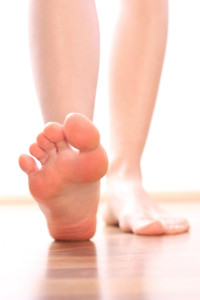 Everyone sweats from time to time, whether it be from nervousness, hot weather, or exercise. While most people sweat as a result of external factors, there are some who excessively sweat without any outside interference. The condition affecting these people is called hyperhidrosis, which leads to excessive sweating in many areas of the body. One of the most common areas to experience intense hyperhidrosis is the feet. Fortunately, there are a few ways to avoid some of the issues associated with hyperhidrosis of the feet. Open toe shoes may not be the best idea for those suffering from hyperhidrosis. Sweaty feet in open toed shoes can lead to slipperiness and instability. Socks are also essential in locking in the sweat and helping to eliminate odors. If you believe you have hyperhidrosis of the feet it is important to speak with a podiatrist in order to learn more about treatment options.
Everyone sweats from time to time, whether it be from nervousness, hot weather, or exercise. While most people sweat as a result of external factors, there are some who excessively sweat without any outside interference. The condition affecting these people is called hyperhidrosis, which leads to excessive sweating in many areas of the body. One of the most common areas to experience intense hyperhidrosis is the feet. Fortunately, there are a few ways to avoid some of the issues associated with hyperhidrosis of the feet. Open toe shoes may not be the best idea for those suffering from hyperhidrosis. Sweaty feet in open toed shoes can lead to slipperiness and instability. Socks are also essential in locking in the sweat and helping to eliminate odors. If you believe you have hyperhidrosis of the feet it is important to speak with a podiatrist in order to learn more about treatment options.
If you are suffering from hyperhidrosis contact Brent Harwood, DPM of Southeast Podiatry. Our doctor can provide the care you need to attend to all of your foot care needs.
Hyperhidrosis of the Feet
Hyperhidrosis is a rare disorder that can cause people to have excessive sweating of their feet. This can usually occur all on its own without rigorous activity involved. People who suffer from hyperhidrosis may also experience sweaty palms.
Although it is said that sweating is a healthy process meant to cool down the body temperature and to maintain a proper internal temperature, hyperhidrosis may prove to be a huge hindrance on a person’s everyday life.
Plantar hyperhidrosis is considered to be the main form of hyperhidrosis. Secondary hyperhidrosis can refer to sweating that occurs in areas other than the feet or hands and armpits. Often this may be a sign of it being related to another medical condition such as menopause, hyperthyroidism and even Parkinson’s disease.
In order to alleviate this condition, it is important to see your doctor so that they may prescribe the necessary medications so that you can begin to live a normal life again. If this is left untreated, it is said that it will persist throughout an individual’s life.
A last resort approach would be surgery, but it is best to speak with your doctor to find out what may be the best treatment for you.
If you have any questions please feel free to contact one of our offices located in Fairhope, Brewton, and Atmore, AL . We offer the newest diagnostic and treatment technologies for all your foot care needs.
Read more about Hyperhidrosis of the Feet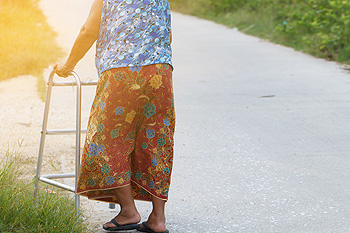 Research has shown foot health may influence the overall well-being of the body. It’s common for many patients to ignore the health of their feet until an uncomfortable foot condition arises. This is especially true of the elder population, and taking proper care of their feet may be difficult as the aging process occurs. There may be noticeable symptoms, which may indicate potential concerns, and these may include the presence of open sores, burning pain and discomfort, or discoloration of the feet. When specific techniques are implemented, which may aid in proper foot care, many uncomfortable foot conditions may be avoided. These may include trimming the toenails straight across, elevating the feet frequently during the day, in addition to wearing shoes that are comfortable and fit correctly. If you would like additional information on how to properly take of elderly feet, it is suggested to speak with a podiatrist who can guide you with the correct knowledge.
Research has shown foot health may influence the overall well-being of the body. It’s common for many patients to ignore the health of their feet until an uncomfortable foot condition arises. This is especially true of the elder population, and taking proper care of their feet may be difficult as the aging process occurs. There may be noticeable symptoms, which may indicate potential concerns, and these may include the presence of open sores, burning pain and discomfort, or discoloration of the feet. When specific techniques are implemented, which may aid in proper foot care, many uncomfortable foot conditions may be avoided. These may include trimming the toenails straight across, elevating the feet frequently during the day, in addition to wearing shoes that are comfortable and fit correctly. If you would like additional information on how to properly take of elderly feet, it is suggested to speak with a podiatrist who can guide you with the correct knowledge.
Proper foot care is something many older adults forget to consider. If you have any concerns about your Feet, contact Brent Harwood, DPM from Southeast Podiatry. Our doctor can provide the care you need to keep you pain-free and on your feet.
The Elderly and Their Feet
As we age we start to notice many changes in our body, but the elder population may not notice them right away. Medical conditions may prevent the elderly to take notice of their foot health right away. Poor vision is a lead contributor to not taking action for the elderly.
Common Conditions
Susceptible Infections
Diabetes and poor circulation can cause general loss of sensitivity over the years, turning a simple cut into a serious issue.
If you have any questions please feel free to contact one of our offices located in Fairhope, Brewton, and Atmore, AL . We offer the newest diagnostic and treatment technologies for all your foot care needs.
Read more about Elderly Foot Care Gout is known to be a painful and uncomfortable condition that typically affects the big toe. This part of the foot may be so sensitive that the weight of a bed sheet may cause intense pain. There are additional symptoms that may be associated with gout, including redness, swelling and extreme heat that may radiate from it. This ailment is said to be caused by excess uric acid in the blood levels that originate from ingesting foods that are laden with purines. Many patients notice these severe symptoms in the big toe, although it may occur in other parts of the body. Specific medications may be prescribed once an attack of gout has occurred, and there may be preventative measures that can be implemented which can possibly avoid this painful condition from occurring. If you feel you may have gout, it is advised to speak with a podiatrist as quickly as possible to learn more about this condition, in addition to beginning the correct treatment.
Gout is known to be a painful and uncomfortable condition that typically affects the big toe. This part of the foot may be so sensitive that the weight of a bed sheet may cause intense pain. There are additional symptoms that may be associated with gout, including redness, swelling and extreme heat that may radiate from it. This ailment is said to be caused by excess uric acid in the blood levels that originate from ingesting foods that are laden with purines. Many patients notice these severe symptoms in the big toe, although it may occur in other parts of the body. Specific medications may be prescribed once an attack of gout has occurred, and there may be preventative measures that can be implemented which can possibly avoid this painful condition from occurring. If you feel you may have gout, it is advised to speak with a podiatrist as quickly as possible to learn more about this condition, in addition to beginning the correct treatment.
Gout is a painful condition that can be treated. If you are seeking treatment, contact Brent Harwood, DPM from Southeast Podiatry. Our doctor will treat your foot care needs.
What Is Gout?
Gout is a form of arthritis that is characterized by sudden, severe attacks of pain, redness, and tenderness in the joints. The condition usually affects the joint at the base of the big toe. A gout attack can occur at any random time, such as the middle of the night while you are asleep.
Symptoms
Risk Factors
Prior to visiting your podiatrist to receive treatment for gout, there are a few things you should do beforehand. If you have gout you should write down your symptoms--including when they started and how often you experience them, important medical information you may have, and any questions you may have. Writing down these three things will help your podiatrist in assessing your specific situation so that he or she may provide the best route of treatment for you.
If you have any questions, please feel free to contact one of our offices located in Fairhope, Brewton, and Atmore, AL . We offer the newest diagnostic and treatment technologies for all your foot care needs.
Read more about Gout A red, tender, and swollen area will appear on the side of the big toe if you are experiencing an ingrown toenail. This uncomfortable condition is typically a result of wearing shoes that fit too tightly, enduring an injury to the toe, or trimming the toenails incorrectly. In more severe cases, there may be an excess of fluid that builds up surrounding the affected area, or the toe could bleed or have pus draining from it. Ingrown toenails develop when the nail grows into the skin on the side of the toe, and pain generally accompanies this ailment. It is suggested to seek treatment as quickly as possible, and this may prevent infection. There are several ways to prevent ingrown toenails from developing, including wearing shoes that fit properly, wearing clean socks, and washing the feet daily. Research has shown that a common treatment method is referred to as a partial nail avulsion, and this involves removing a portion of the infected toenail. If you feel you have developed an ingrown toenail, it is advised to counsel with a podiatrist, so the best treatment option can be determined.
A red, tender, and swollen area will appear on the side of the big toe if you are experiencing an ingrown toenail. This uncomfortable condition is typically a result of wearing shoes that fit too tightly, enduring an injury to the toe, or trimming the toenails incorrectly. In more severe cases, there may be an excess of fluid that builds up surrounding the affected area, or the toe could bleed or have pus draining from it. Ingrown toenails develop when the nail grows into the skin on the side of the toe, and pain generally accompanies this ailment. It is suggested to seek treatment as quickly as possible, and this may prevent infection. There are several ways to prevent ingrown toenails from developing, including wearing shoes that fit properly, wearing clean socks, and washing the feet daily. Research has shown that a common treatment method is referred to as a partial nail avulsion, and this involves removing a portion of the infected toenail. If you feel you have developed an ingrown toenail, it is advised to counsel with a podiatrist, so the best treatment option can be determined.
Ingrown toenails may initially present themselves as a minor discomfort, but they may progress into an infection in the skin without proper treatment. For more information about ingrown toenails, contact Brent Harwood, DPM of Southeast Podiatry. Our doctor can provide the care you need to keep you pain-free and on your feet.
Ingrown Toenails
Ingrown toenails are caused when the corner or side of a toenail grows into the soft flesh surrounding it. They often result in redness, swelling, pain, and in some cases, infection. This condition typically affects the big toe and may recur if it is not treated properly.
Causes
You are more likely to develop an ingrown toenail if you are obese, have diabetes, arthritis, or have any fungal infection in your nails. Additionally, people who have foot or toe deformities are at a higher risk of developing an ingrown toenail.
Symptoms
Some symptoms of ingrown toenails are redness, swelling, and pain. In rare cases, there may be a yellowish drainage coming from the nail.
Treatment
Ignoring an ingrown toenail can have serious complications. Infections of the nail border can progress to a deeper soft-tissue infection, which can then turn into a bone infection. You should always speak with your podiatrist if you suspect you have an ingrown toenail, especially if you have diabetes or poor circulation.
If you have any questions, please feel free to contact one of our offices located in Fairhope, Brewton, and Atmore, AL . We offer the newest diagnostic and treatment technologies for all your foot care needs.
Read more about Ingrown Toenails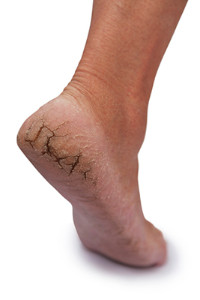 Many people who enjoy walking barefoot or wearing flip-flops during the summer months may be surprised to learn that there may be consequences that can follow as a result of this. The skin may become dry, calluses may possibly form, and fissures in the skin of the heels, known as cracked heels, may develop. If the cracks in the skin should bleed, severe pain, discomfort, and infection may accompany this condition. There may be remedies that can be practiced to prevent and relieve extremely dry skin, and these may include washing and drying the feet thoroughly followed by utilizing a good moisturizer. At this point, it is suggested to wear socks while sleeping for the night, and this may aid in healing painful fissures. If you would like additional information about how to treat cracked heels, it is advised to consult with a podiatrist who can discuss the best options for you.
Many people who enjoy walking barefoot or wearing flip-flops during the summer months may be surprised to learn that there may be consequences that can follow as a result of this. The skin may become dry, calluses may possibly form, and fissures in the skin of the heels, known as cracked heels, may develop. If the cracks in the skin should bleed, severe pain, discomfort, and infection may accompany this condition. There may be remedies that can be practiced to prevent and relieve extremely dry skin, and these may include washing and drying the feet thoroughly followed by utilizing a good moisturizer. At this point, it is suggested to wear socks while sleeping for the night, and this may aid in healing painful fissures. If you would like additional information about how to treat cracked heels, it is advised to consult with a podiatrist who can discuss the best options for you.
If the skin on your feet starts to crack, you may want to see a podiatrist to find treatment. If you have any concerns, contact Brent Harwood, DPM from Southeast Podiatry. Our doctor can provide the care you need to keep you pain-free and on your feet.
Cracked Heels
It is important to moisturize your cracked heels in order to prevent pain, bleeding, and infection. The reason cracked heels form is because the skin on the foot is too dry to support the immense pressure placed on them. When the foot expands, the dry skin on the foot begins to split.
Ways to Help Heal Them
Ways to Prevent Cracked Heels
If you are unsure how to proceed in treating cracked heels, seek guidance from a podiatrist. Your doctor will help you with any questions or information you may need.
If you have any questions, please feel free to contact one of our offices located in Fairhope, Brewton, and Atmore, AL . We offer the newest diagnostic and treatment technologies for all your foot care needs.
Read more about Solutions for Cracked Heels People who enjoy the sport of running understand the importance of choosing the right type of running shoe. This may aid in keeping the muscles and joints healthy and may maximize the benefits of running. The feet have different functions when walking and running are practiced and it’s important to choose the correct shoe. Running is a high impact exercise and the feet will generally absorb three times the weight of the body. People who enjoy walking will notice the body’s weight is much more evenly distributed between the feet and the legs and may benefit by choosing shoes with adequate arch support. When deciding on a running shoe, you may notice the sole is stiffer and there is more cushioning in the heel area. Additionally, they tend to be generally lighter in weight than walking shoes, which may aid the runner to have faster mobility. If you would like additional information about the differences between walking and running shoes, it is suggested to speak with a podiatrist.
People who enjoy the sport of running understand the importance of choosing the right type of running shoe. This may aid in keeping the muscles and joints healthy and may maximize the benefits of running. The feet have different functions when walking and running are practiced and it’s important to choose the correct shoe. Running is a high impact exercise and the feet will generally absorb three times the weight of the body. People who enjoy walking will notice the body’s weight is much more evenly distributed between the feet and the legs and may benefit by choosing shoes with adequate arch support. When deciding on a running shoe, you may notice the sole is stiffer and there is more cushioning in the heel area. Additionally, they tend to be generally lighter in weight than walking shoes, which may aid the runner to have faster mobility. If you would like additional information about the differences between walking and running shoes, it is suggested to speak with a podiatrist.
For more information about walking shoes versus running shoes, consult with Brent Harwood, DPM from Southeast Podiatry. Our doctor can measure your feet to determine what your needs are and help you find an appropriate pair of footwear.
Foot Health: The Differences between Walking & Running Shoes
There are great ways to stay in shape: running and walking are two great exercises to a healthy lifestyle. It is important to know that running shoes and walking shoes are not interchangeable. There is a key difference on how the feet hit the ground when someone is running or walking. This is why one should be aware that a shoe is designed differently for each activity.
You may be asking yourself what the real differences are between walking and running shoes and the answers may shock you.
Differences
Walking doesn’t involve as much stress or impact on the feet as running does. However, this doesn’t mean that you should be any less prepared. When you’re walking, you land on your heels and have your foot roll forward. This rolling motion requires additional support to the feet.
Flexibility – Walking shoes are designed to have soft, flexible soles. This allows the walker to push off easily with each step.
If you have any questions, please feel free to contact one of our offices located in Fairhope, Brewton, and Atmore, AL . We offer the newest diagnostic and treatment technologies for all your foot care needs.
Read more about Walking Shoes vs. Running Shoes Research has shown blisters to be the most common medical condition among marathon runners. This may be a result of continued friction caused from the sock or shoe that is worn while running. As the skin becomes gradually damaged, the body creates a bubble containing fluid to act as a natural protectant. Research has shown similarities between people who commonly get blisters. These similarities may include performing vigorous activities that may consist of repetitive force, such as jumping and running; shoes that may fit incorrectly; or possibly from feet that have an unusual shape. There are measures that may be taken to possibly prevent blisters, including wearing shoes that are comfortable and fit properly, applying powder in shoes and socks, or taping the feet where a blister may occur. If you have a blister that is recurring and causes pain and discomfort, speak with a podiatrist who can offer proper prevention and treatment solutions.
Research has shown blisters to be the most common medical condition among marathon runners. This may be a result of continued friction caused from the sock or shoe that is worn while running. As the skin becomes gradually damaged, the body creates a bubble containing fluid to act as a natural protectant. Research has shown similarities between people who commonly get blisters. These similarities may include performing vigorous activities that may consist of repetitive force, such as jumping and running; shoes that may fit incorrectly; or possibly from feet that have an unusual shape. There are measures that may be taken to possibly prevent blisters, including wearing shoes that are comfortable and fit properly, applying powder in shoes and socks, or taping the feet where a blister may occur. If you have a blister that is recurring and causes pain and discomfort, speak with a podiatrist who can offer proper prevention and treatment solutions.
Blisters are prone to making everyday activities extremely uncomfortable. If your feet are hurting, contact Brent Harwood, DPM of Southeast Podiatry. Our doctor can provide the care you need to keep you pain-free and on your feet.
Foot Blisters
Foot blisters develop as a result of constantly wearing tight or ill-fitting footwear. This happens due to the constant rubbing from the shoe, which can often lead to pain.
What Are Foot Blisters?
A foot blister is a small fluid-filled pocket that forms on the upper-most layer of the skin. Blisters are filled with clear fluid and can lead to blood drainage or pus if the area becomes infected.
How Do Blisters Form?
Blisters on the feet are often the result of constant friction of skin and material, usually by shoe rubbing. Walking in sandals, boots, or shoes that don’t fit properly for long periods of time can result in a blister. Having consistent foot moisture and humidity can easily lead to blister formation.
Prevention & Treatment
It is important to properly care for the affected area in order to prevent infection and ease the pain. Do not lance the blister and use a Band-Aid to provide pain relief. Also, be sure to keep your feet dry and wear proper fitting shoes. If you see blood or pus in a blister, seek assistance from a podiatrist.
If you have any questions, please feel free to contact one of our offices located in Fairhope, Brewton, and Atmore, AL . We offer the newest diagnostic and treatment technologies for all your foot care needs.
Read more about Blisters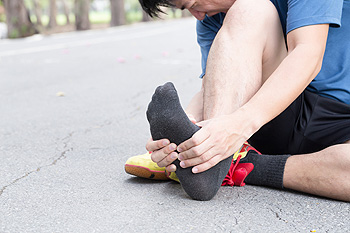 Research has shown there are over 26 bones and several ligaments and tendons that are in each foot. If an injury is experienced in any portion of the foot or if a medical ailment develops, foot pain or difficulty in walking may be indicative of a serious foot condition. A source of uncomfortable foot pain may originate from a condition that is referred to as plantar fasciitis, and this will typically affect the heel of the foot. If you engage in running or jumping activities for extended periods of time, you may develop metatarsalgia. If you have this type of foot pain, you may notice discomfort in the middle of the foot. Additionally, foot pain that comes from tarsal tunnel syndrome will affect the nerves of the foot. If you have any type of foot pain, it is advised to seek the counsel of a podiatrist that can determine the cause of the pain and recommend proper treatment options.
Research has shown there are over 26 bones and several ligaments and tendons that are in each foot. If an injury is experienced in any portion of the foot or if a medical ailment develops, foot pain or difficulty in walking may be indicative of a serious foot condition. A source of uncomfortable foot pain may originate from a condition that is referred to as plantar fasciitis, and this will typically affect the heel of the foot. If you engage in running or jumping activities for extended periods of time, you may develop metatarsalgia. If you have this type of foot pain, you may notice discomfort in the middle of the foot. Additionally, foot pain that comes from tarsal tunnel syndrome will affect the nerves of the foot. If you have any type of foot pain, it is advised to seek the counsel of a podiatrist that can determine the cause of the pain and recommend proper treatment options.
Foot Pain
Foot pain can be extremely painful and debilitating. If you have a foot pain, consult with Brent Harwood, DPM from Southeast Podiatry. Our doctor will assess your condition and provide you with quality foot treatment.
Causes
Foot pain is a very broad condition that could be caused by one or more ailments. The most common include:
Diagnosis
To figure out the cause of foot pain, podiatrists utilize several different methods. This can range from simple visual inspections and sensation tests to X-rays and MRI scans. Prior medical history, family medical history, and any recent physical traumatic events will all be taken into consideration for a proper diagnosis.
Treatment
Treatment depends upon the cause of the foot pain. Whether it is resting, staying off the foot, or having surgery; podiatrists have a number of treatment options available for foot pain.
If you have any questions, please feel free to contact one of our offices located in Fairhope, Brewton, and Atmore, AL . We offer the newest diagnostic and treatment technologies for all your foot care needs.
Read more about Foot Pain If you have consistent pain and discomfort in the heel of your foot, you may have a medical condition that is referred to as plantar fasciitis. It will typically target people who are active in running sports, or for those who stand for the majority of the day. This ailment is a result of inflammation that occurs in the long portion of tissue that runs along the bottom of the foot, which links the toes to the heel, and this is known as the plantar fascia. A common symptom of this ailment is severe heel pain, which may often be worse in the morning when the first steps are taken. Some patients have specific tendencies that may encourage the development of this condition, including being overweight, wearing shoes that do not fit correctly, or are born with flat feet or high arches. There are possible techniques that may offer moderate relief, and these may include performing proper foot stretches, resting your feet as often as possible, or wearing shoe inserts. If you have developed this condition, it’s suggested to speak with a podiatrist to understand what treatment options are correct for you.
If you have consistent pain and discomfort in the heel of your foot, you may have a medical condition that is referred to as plantar fasciitis. It will typically target people who are active in running sports, or for those who stand for the majority of the day. This ailment is a result of inflammation that occurs in the long portion of tissue that runs along the bottom of the foot, which links the toes to the heel, and this is known as the plantar fascia. A common symptom of this ailment is severe heel pain, which may often be worse in the morning when the first steps are taken. Some patients have specific tendencies that may encourage the development of this condition, including being overweight, wearing shoes that do not fit correctly, or are born with flat feet or high arches. There are possible techniques that may offer moderate relief, and these may include performing proper foot stretches, resting your feet as often as possible, or wearing shoe inserts. If you have developed this condition, it’s suggested to speak with a podiatrist to understand what treatment options are correct for you.
Plantar fasciitis is a common foot condition that is often caused by a strain injury. If you are experiencing heel pain or symptoms of plantar fasciitis, contact Brent Harwood, DPM from Southeast Podiatry. Our doctor can provide the care you need to keep you pain-free and on your feet.
What Is Plantar Fasciitis?
Plantar fasciitis is one of the most common causes of heel pain. The plantar fascia is a ligament that connects your heel to the front of your foot. When this ligament becomes inflamed, plantar fasciitis is the result. If you have plantar fasciitis you will have a stabbing pain that usually occurs with your first steps in the morning. As the day progresses and you walk around more, this pain will start to disappear, but it will return after long periods of standing or sitting.
What Causes Plantar Fasciitis?
There are some risk factors that may make you more likely to develop plantar fasciitis compared to others. The condition most commonly affects adults between the ages of 40 and 60. It also tends to affect people who are obese because the extra pounds result in extra stress being placed on the plantar fascia.
Prevention
There are a variety of treatment options available for plantar fasciitis along with the pain that accompanies it. Additionally, physical therapy is a very important component in the treatment process. It is important that you meet with your podiatrist to determine which treatment option is best for you.
If you have any questions, please feel free to contact one of our offices located in Fairhope, Brewton, and Atmore, AL . We offer the newest diagnostic and treatment technologies for all your foot care needs.
Read more about Plantar Fasciitis
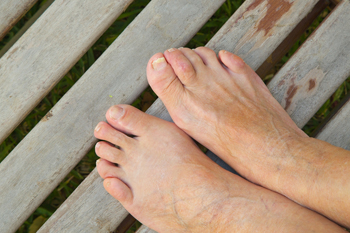 If you notice a sizable bump on the second toe of your foot, you may have what can develop into a hammertoe. Many people experience a bunion first, and this will typically occur on the side of the big toe. As this condition develops, the toes push against each other causing the middle toe to bend downward, and this may cause pain and discomfort. Research has shown this condition may be more apt to develop in people who are experiencing arthritis in the bones of the feet. There may be preventive measures to halt this ailment from happening, including wearing shoes that have adequate room for the toes to move about it in. Moderate relief may be found by performing specific exercises that can stretch the toes. One example would be to try soaking the feet in warm water daily, followed by pointing the toes. This may benefit in stretching the tendons of the toe. If you feel you are developing this condition, please consult with a podiatrist for treatment options that are correct for you.
If you notice a sizable bump on the second toe of your foot, you may have what can develop into a hammertoe. Many people experience a bunion first, and this will typically occur on the side of the big toe. As this condition develops, the toes push against each other causing the middle toe to bend downward, and this may cause pain and discomfort. Research has shown this condition may be more apt to develop in people who are experiencing arthritis in the bones of the feet. There may be preventive measures to halt this ailment from happening, including wearing shoes that have adequate room for the toes to move about it in. Moderate relief may be found by performing specific exercises that can stretch the toes. One example would be to try soaking the feet in warm water daily, followed by pointing the toes. This may benefit in stretching the tendons of the toe. If you feel you are developing this condition, please consult with a podiatrist for treatment options that are correct for you.
Hammertoes can be a painful condition to live with. For more information, contact Brent Harwood, DPM of Southeast Podiatry. Our doctor will answer any of your foot- and -related questions.
Hammertoe
Hammertoe is a foot deformity that occurs due to an imbalance in the muscles, tendons, or ligaments that normally hold the toe straight. It can be caused by the type of shoes you wear, your foot structure, trauma, and certain disease processes.
Symptoms
Risk Factors
Treatment
If you have hammertoe, you should change into a more comfortable shoe that provides enough room for your toes. Exercises such as picking up marbles may strengthen and stretch your toe muscles. Nevertheless, it is important to seek assistance from a podiatrist in order to determine the severity of your hammertoe and see which treatment option will work best for you.
If you have any questions, please feel free to contact one of our offices located in Fairhope, Brewton, and Atmore, AL . We offer the newest diagnostic and treatment technologies for all your foot care needs.
Read more about Hammertoe